#of the animerama trilogy
Explore tagged Tumblr posts
Text
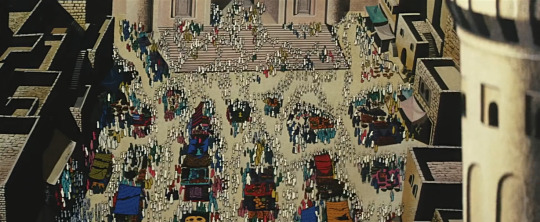
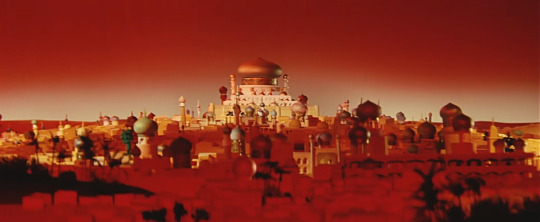
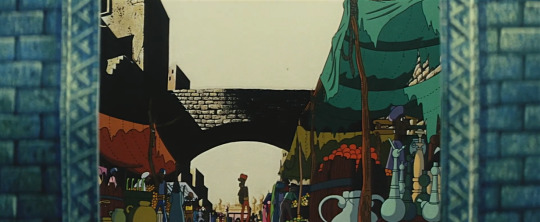
#:1001 Nights#openings shots... again with a lot of experimentation. I can't say I don't like that element#of the animerama trilogy
6 notes
·
View notes
Text
Season 3 Ramble #8 - A is for Anime(solo reprise) ver.3
Hadn't been doing the run-up posting I usually do for my rambles due to work and such but here we are!
How this ramble is gonna go is I'm gonna list my top 3 movies watched this month then top 3 series for same, AAnd now that I actually have a semi decent number of anime under my belt I'm gonna do a quick top ten of both at the end.. after that if you wanna stick around, instead of the usual post ramble ramble, I'm gonna add a bit of the recording I did with the homies, as a sort of prelude and promise that we will have that conversation in future. I really think it's an important and potentially fruitful discussion to have.
But In any case getting into the episode now
TOP 3 MOVIES
3) Belladonna Of Sadness (1973, 1hr33m, Mushi Production)
Crazy movie. I don't think I can accurately talk about it without it sounding too wHild… I'm still gonna, but I'm gonna open with what Google says about it.
A peasant woman is raped by the local lord on her wedding night. To take revenge, she makes a pact with the Devil himself who appears as an erotic sprite and transforms her into a black-robed vision of madness and desire.
As I said.. wHild… and that's just the summary…the details of the actual movie are like…woah.. but in any case it was great, actually something that'd been on my watch list for a good long while so I'm glad I could actually finally watch it.

Glazing over the plot which the summary does a pretty good job of covering anyways, the visuals were absolutely stunning. They're by Yoshitaka Amano, probably most famously known for his final fantasy illustrations. For the most part the visuals are done in what looks like watercolor paint, which is just wild in my mind,, like wHy?? He definitely pulled it off though which is even more crazy cause a good amount of it was done in an almost slideshow kinda way which I usually don't like but he still pulled it off…crazy…. Should be kinda obvious from the summary but moderate tw. Still definitely strongly recommend.
Small sidenote - in making this ramble I found out that belladonna of sadness is actually part of a trilogy called animerama,, so now I have 2 more old ass movies to look forward to. Hopefully they're just as good or even better…
2) Lupin IIIrd: The Gravestone of Daisuke Jigen (2014, 51m, Telecom Animation Film)
Ever since I watched my first lupin movie 3 years ago I've been locked in. In fact it was such a good watch that I've limited myself to one a year. Thankfully the trend of awesomeness has continued up to this point but enough premature glazing.
This movie is basically centered on Jigen, as you can probably tell from the title. Just a point of clarity for those who don't know much of anything about lupin, Jigen is basically the gunslinger of Lupin’s crew. So as this is basically his movie, he's ofc facing off against a gunslinger. The title is so named because this guy, the gunslinger they find themselves up against, makes graves for his victims before killing them. Nobody's ever gotten away from him. In fact he's so good that he uses dice to decide how many bullets he'll use to take out his target. Ice cold mf.

Pretty good action from start to finish though I’m a tad disappointed there wasn't more gun-slinging, though from what I gather Jigen’s whole thing is speed, accuracy and efficiency,, so maybe a barrage of bullets wouldn't have made sense. In any case we get to see all of the crew besides goemon, dry cry as he's my personal fav but still solid. The art direction was great from all angles as I've come to expect. Not too much to say cast wise as on Lupin gang’s side there's a cumulative effect of greatness where every time you see them it's generally a continuation of past interactions, as in there's an obviously rich history there. That being said, the dynamic is still great and from what I've seen, you can pick up any of the movies and immediately love them. But anyways, on the other hand, the main villain/organization felt a bit hollow. Which is something I've come to kind of expect with movie exclusive antagonists in general. It's just a matter of time efficiency. I think when it comes to anime movies, you're generally not watching for the antagonist unless they have to do with the main storyline. Otherwise you're kinda watching to see how the protagonist will beat them in about an hour. Though I will say as far as visuals can speak, they definitely spoke volumes in that sense. Also, given the geopolitical climate we're in, I liked the villain/organization and how they were handled... trying not to spoil too much there but if you so much as peek between the lines you probably get it.. In any case definitely highly recommend.

Side note - every lupin movie I watch further solidifies my decision to get into the series… just watching the movies first for some reason…
1) Mind game (2004, 1hr44m, Studio 4°C)
Honestly,, I don't even want to speak on it for fear of sullying its greatness. It's one of those life changing before and after watches fr. This is something I'd been really wanting to watch since ver.1 when I started getting into Studio 4°C through their awesome anthologies genius party and genius party beyond.
I'm gonna default to the anilist description here which is kinda almost decent relative to the sheer phenomenal amazingness of this movie.. but I digress.. so according to anilist..

Audiences will begin to grasp what they are in for early on, as loser Nishi, too wimpy to try to save his childhood sweetheart from gangsters, is shot in the butt by a soccer-playing psychopath, projecting Nishi into the afterlife. In this limbo, God - shown as a series of rapidly changing characters - tells him to walk toward the light. But Nishi runs like hell in the other direction and returns to Earth a changed man, driven to live each moment to the fullest.
The last bit hints at the greatness of this film. Right there that small difference in speech speaks volumes in my personal world of language. It's not just a movie. It's film. 10/10. absolute cinema.

As I said I don't even want to talk about it too much because I don't think it possible to do it justice through mere words, but I'm gonna put a bit more glaze on it before I wrap up the movie list and move on to series. This movie beat out studio ghibli’s, Miyazaki directed, howl’s moving castle in the 2004 Japan Media Arts Festival. Further, this was a debut work for the director Masaaki Yuasa, who would later go on to found science saru studio. I was so moved by this movie that I've decided I will watch everything masaaki yuasa has and will ever direct. 10/10. highly recommend. end of glaze.
hm: under the dog, Mezzo forte, blood: the last vampire, 4°c (sweat punch, short peace from last time)
Top 3 Series
3) Frieren: Beyond Journey's End (2023-2024, 28ep 24m, Madhouse)
This is something I'd been seeing around for a bit but was intentionally ignoring because for some reason I got it in my head that it was based on this sad little one shot called The hero’s party on their way back home, and I was NOT watching an entire series based on that.
In any case, in talking with my bros recently they all insisted that it was the best anime released in the past year, one of them declaring it was in his top5 all time. So I pushed past my fears and binged it all in a day. V thankful for the bros.
The story here follows an elven mage called frieren and her life after defeating the Demon King and bringing peace to the world.

As you can tell from the summary it's largely a slice of life but it has its fair share of well placed scraps. It fills a certain fantasy gap where you get that day to day rose tinted indigenous peoples’ lifestyle feel, that I think most people would want if they actually lived in a fantasy setting,, not that constantly under threat from dragons and shit usually focused on. And as I said there are some well placed fights. The pacing also felt perfect. Like I almost felt bad binging it because I could tell that once a week watch would've been REALLY good… one of the few series I don't want to read the manga for, I'll definitely be watching weekly whenever season 2 drops..
Great cast though kinda small, pretty brilliant visuals and sound direction. Very very very solid all round, what I'd call supremely balanced tbh. One of the bros put it really well in that he said he has synesthesia so everything has colours for him, and the colours of every aspect of this show came together to paint the perfect picture. Now I don't have synesthesia myself but I could definitely feel, not just see, how well orchestrated it all was. definitely strongly recommend.
2) Tengen Toppa Gurren Lagann (2007, 27ep 24m, Gainax)
Yes. It's 2024 and I’m just watching gurren lagann and you'll hear why that is if you listen in to the post ramble ramble,, but suffice to say, you can never be late to true greatness and Tengen Toppa Gurren Lagann is definitely in that category.

Firstly I kinda watched it as a meme seeing as last ramble I focused on the supposed relationship between sacred geometry and JoJo's bizarre adventure… if that sounds crazy then you should listen to the ramble… not that it'll sound less crazy but..yh.. anyways I was vaguely aware that gurren lagann focused a bit on spirals so I tapped in for the meme.
To summarize the lengthy anilist summary,, In a far away future, mankind lives underground in huge caves, unknowing of a world above with a sky and stars. yada yada yada blah blah blah Simon, Kamina, Yoko, and the small yet sturdy robot, Lagann, journey to the world above and find that the surface is a harsh battlefield, and it's up to them to fight back against the rampaging Beastmen. Pierce the heavens, Gurren Lagann!

Again I'm gonna fall back on the words of another of my bros from the session, I think he had it in his top 10 or 5,, but he said he considers gurren lagann to be a perfect starter anime in that it perfectly showcases almost everything the medium of anime has to offer. Action, comedy, philosophy, slice of life, amazing cast, brilliant visual direction, solid sound direction. etc. the term “starter anime” gets thrown around a fair bit and I usually think it's a rubbish term because of how insanely diverse the medium is and how specific different individuals tastes can be,, so like to say this or that anime is a good “starter anime" never made sense.. but when he said it, that was the very first time I actually thought it made sense..
Definitely super highly recommend, a recommendation to pierce the heavens if you will.
1) Akiba Maid War (2022, 12ep 24m, P.A Works)
Gotta say it was a tough call between this and gurren lagann but it won out for 3 reasons. #1 it's shorter, and that's not a lazy pov, I just personally tend to give more ratings to shorter series in general because I think being able to do something amazing in a short amount of time deserves more props than doing so in a longer span of time. personally.. #2 it was FUNNY. AS. FUCK. I'm coming to realize that when it comes to anime specifically, comedy may be my favourite genre. I can't quite put my finger on why but I think it has to do with how far animation as a medium can push physical humor.. idk.. lastly… idek why I felt the need to justify all this…it's my list… but lastly,, and most importantly. maids. enough said..

The story here follows the dealings of different maid cafes in the town of Akihabara. I say dealings because in this show the maids basically act like Yakuza, having turf wars, extortion rackets and drug trades(just a point of clarity for those who've never heard the term, you've probably guessed but Yakuza are basically Japanese gangsters). In any case this is all under the table as they pay off the police and act the usual cutesy part in front of civilians. That may be a bit of a spoiler but a gif of it was going around a lot last year i think,, with this one maid gunning down a bunch of other maids and it was made to look like an idol rave with the glow sticks and everything + the “twist" if you can even call it that happens in episode 1 so it's not like some major turning point spoilers + "wars” is literally in the title, so with all due respect, you can bite me..

In any case, as I said this shit was funny ASF, mainly because of the opposing imagery of maids and yakuza they somehow pulled off perfectly.. like I can't begin to explain how crazy it is to see maids cussing each other out with the most obscene language, fighting it out in the craziest brawls, then turning around and going “welcome home master”.
Fairly small but very strong cast, all funny in their own unique ways from the hardened criminal type to the frightened newbie. the visuals were great, sounds direction solid, I really really loved the op and ed, cause they just perfectly matched the shows energy. Kinda episodic for the most part but that fit the crazy, “you'll never guess what happens next” energy… Just great overall like wow.. a bit surprised I haven't seen it around more but I realize comedies don't tend to get that much ratings on release, if they do get attention it's further down the line as a “hidden jewel".
But in any case yes. 10/10. definitely highly recommend. please go watch this. have a good laugh, give thanks for life and go see the beauty of the world.
hm: Flying Trapeze, Goodbye Mr. despair (from s2)
Top 10 Movies (no order)
A Silent Voice, Memories (anthology directed by katsuhiro otomo), One Piece Movie 6: Flower Island, Tokyo Godfathers, Mind Game, Ocean Waves, Nausicaa Of The Valley Of The Wind, Sword Of The Stranger, the Lupin movies (just watch all of them lol), Maquia: When The Promised Flower Blooms
hm: Words Bubble Up Like Soda Pop, Animatrix, GITS Innocence, Wolf Children, Princess Mononoke
Top 10 Series (no order)
Tengen Toppa Gurren Lagann, Akiba Maid Wars, Nichijou, Hyouka, Mononoke, Sonny Boy, Tatami Galaxy(all spinoffs, movies, everything.), Steins;Gate, Dorohedoro, Angel Beats, Durarara!!(all seasons)
hm: Baccano!, Pluto, FLCL up to Progressive, Cowboy Bebop, chainsaw man
#just another day#mm..manga#writeup#belladonna of sadness#lupin IIIrd: the gravestone of daisuke jigen#mind game#frieren: beyond journey's end#tengen toppa gurren lagan#akiba maid war
9 notes
·
View notes
Text
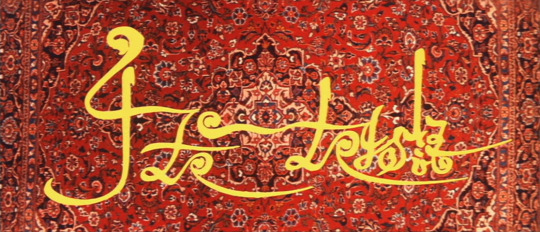
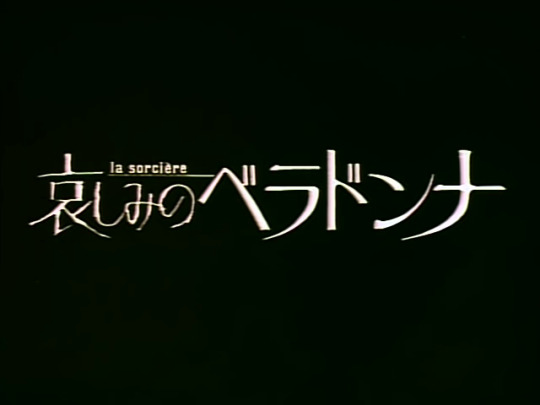
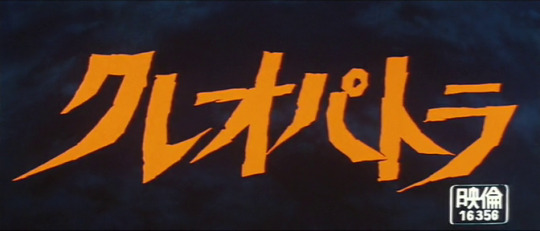
Now here are some real gems. The World Master Piece Theater titles i've been picking out of the pile might be classics but they were all fairly safe and stable works both artistically, financially, and culturally. But MushiPro's ANIMERAMA film trilogy were boldly ambitious, bordering on avante garde, and delightfully irreverently bizarre. They didn't tend to do great at the box offices but coasted by on the power of Osamu Tezuka's reputation.
1001 Nights, the first of the three, actually performed fairly well and even earns itself a little historical footnote as one of the world's earliest feature length animated erotica. Its English dub even beat Ralph Bakshi's infamous Fritz the Cat to theaters by a couple of years, although it's impact on a US market was nearly nonexistant.
Belladonna of Sadness has had an odd resurgence in cult classic status as of the past few years for some odd reason. It sports a very brash 70s brand of feminism and sexual liberation in addition to its erotica and psychidelic themes. It draws from the 1862 "historical" text, La Sorcière. It was notable for being a record of the "history" of witchcraft in Europe, but one with a relatively sympathetic view of pagan rebelliousness against the catholic church. It's also drawing from those themes of rebellion as innate to witchcraft that the movie plays with themes of the French Revolution and 2nd wave feminism. It was a financial flop but has endured as a cult classic.
Less favorable to box office number and critics alike was Cleopatra. Other than some bad advertising/marketing it had a weird mix of styles, including bits of rotoscoped animation, and walked an odd line in being raunchy but not actually pornographic, which resulted in aforementioned muddled advertising efforts. It's also just kind of a jumble of a plot about time travelers going back in time to stop aliens from masquerading as Cleopatra and seducing the great leaders of the ancient world and rewriting the history of humanity.
3 notes
·
View notes
Text
Animation Night 146: Leiji Matsumoto
Tragically there is a death in the news this week: Leiji Matsumoto, renowned creator of Space Battleship Yamato, Captain Harlock, and Galaxy Express 999. I’d like to commemorate him with an Animation Night...
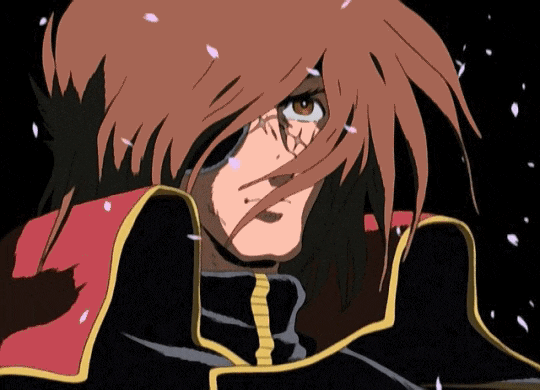
It would be hard to think of a scifi mangaka or anime director more influential than Matsumoto beyond, well, Osamu Tezuka himself. Sure, Tomino, Anno, Rintaro - but who were they influenced by? Space Battleship Yamato is the bridge from goofy monster-of-the-week super robots to the dramatic anime that would eventually develop in the 80s onwards. So let’s start there.
As recounted in some detail here, Leiji Matsumoto grew up during the second world war; he struggled to find much of an audience for many years until his Senjō WWII manga started to become popular in 1971. This led, in turn, to Matsumoto joining the Space Battleship Yamato project in 1973 alongside producer Yoshinobu Nishizaki, and Eiichi Yamamoto of (no seriously) the ‘Animerama’ trilogy of erotic films, notably Belladonna of Sadness.
When Matsumoto joined the project, the plan was for it to be a dark ‘Lord of the Flies in space’ space drama. Matsumoto was at this time a WWII mangaka, so with WWII on the brain, it’s not entirely surprising that he drew most of his ideas from the war. It was his idea to design the spaceship after the actual battleship Yamato, a major symbol of Imperial Japan that in fact did very little before she was sunk in 1945.

Space Battleship Yamato shows a spaceship built in the ruined shell of the battleship, sailing around in space to fight against an alien invasion. It is armed with a superweapon called the ‘Wave Motion Cannon’ (波動砲 hadōhō), which became a standard term for a huge scifi laser weapon. Matsumoto planned to pattern events in the series after real battles in the world war. But the production was cut down, from 52 episodes to 26, and the story simplified, losing a lot of the antagonist’s motivation. Even so, it was a lot more complex than TV anime at the time was used to, a first step on the path to the complex, dark sci-fi anime and manga of the 80s and 90s.
The TV series struggled for ratings until the release of a compilation film in 1977, which kicked off a surge of ‘Yamato fever’. Its character archetypes, like the gruff paternal bridge captain, became stock characters. And while for most part the animation in the series was limited, it was an opportunity for Kazuhide Tomonoga to create some landmark mechanical animation of the sinking of the original Yamato.
Yamato was among the earliest wave of anime to be released outside of Japan. It gaining a following in Europe, and in America it was retitled and edited as Star Blazers. Contemporary critics dismissed it as a poorly animated knockoff of Star Wars, yet it continued to snowball in popularity. You might spot nods to it in various places; Miyazaki put a wrecked Yamato in Nausicaa as a gesture against its militaristic themes.
And it’s hard not to see something almost ludicrously nationalistic in a story about a resurrected Japanese battleship defending the Earth against invaders in a way it couldn’t defend Japan during its actual operation. We might think of the scene in Grave of the Fireflies where Seita imagines his father sailing away on a mighty warship. Matsumoto’s later works would generally veer away from such themes towards more personal stories in the same wide, imaginative scifi setting.

Captain Harlock is a kind of ‘eternal warrior’ type figure; the above cited article compares him to the characters of Michael Moorcock. He’s based on a character created by Matsumoto in highschool, and indeed he is kind of chuuni as a character: he’s a badass space pirate with a skull and crossbones and a cool scar and a swishy cloak. But Matsumoto was way ahead of the game with these motifs, and before long he got the opportunity to give Harlock his own show... at Toei.
But Matsumoto was finished in the director’s chair. He’d write the manga, and Rintaro (c.f. Animation Night 134) would get to direct it, drawing on his time under the wing of Dezaki. Harlock was an enormous success, one of the defining anime of the 70s, wildly popular in Europe as well as Albator.
Harlock spawned numerous TV series - for our purpose the notable one is Arcadia of my Youth (1982), which serves as a kind of prequel to the series with the origin story of Captain Harlock. What better place to begin than the beginning? Its director, Tomoharu Katsumata, is otherwise known for adapting many of Go Nagai’s works to film. The story sets up Harlock as belonging to a lineage that belongs on Earth with pilots called Phantom F. Harlock I/II, setting up the unsettling characterisation of Harlock II as fighting for the Nazis out of a sense of feudal obligation despite his misgivings towards the war.
This highlights the sort of strange tension that seems to exist in Matsumoto’s works. Many of his WWII-set stories are tragedies about pointless and futile deaths in war, featuring reluctant soldiers for the Axis who are not fascist ideologues but nevertheless fight for the cause. But he also likes to imagine that these figures could be redeemed and resurrected fight against the space imperialists. I imagine growing up in Imperial Japan during the war really does something to a person! Anyway I don’t know if I’m reading this right - I need to experience more of Matsumoto’s work to fully see if I think I understand what he’s going for, I think.
In any case, the enormous success of Harlock led to many further adaptations of Matsumoto’s manga such as Starzinger (Journey to the West in space), Danguard Ace (super robots), and ultimately of course Galaxy Express 999, a long bildungsroman about a boy who leaves Earth on a spacebound train - first as a TV anime and then the pair of movies directed by Rintaro in 1980 and 1981.
Compared to the somewhat formulaic TV series, the films were tight and compelling. By this time the renowned ‘charisma animator’ Yoshinori Kanada had really hit his stride, and was ready to essentially duel Tomonaga over who could create a more impressive depiction of a planet exploding into liquid fire, making Galaxy Express 999 not just an influential classic film but a real landmark of animation.
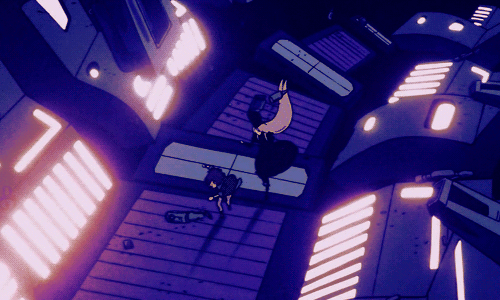
All of these scifi projects are closely tied in together; if you start digging with Matsumoto you start finding all sorts of intricate connections, characters recurring in different series, altogether comprising a ‘Leijiverse’. And of course in such a big body of work there are many recurring themes - conquering empires and mysterious women who are probably queen of somewhere. His most popular works, meanwhile, spawned remakes and sequels in abundance. Matsumoto became less central after these major successes, but continued to inspire anime productions - often at Toei and Madhouse - throughout the 90s. Read about them here if you’re curious!
One of the most surprising twists is the Daft Punk film Interstella 5555: The 5tory of the 5ecret 5tar 5ystem. The French duo had grown up watching adaptations of Matsumoto’s works on French TV, and when they decided to make a film to support their album, his style was a natural fit. So Matsumoto was called back up to Toei to supervise the film. We’ll talk more about this soon - I’m planning a music themed Animation Night, which was going to be tonight but I realised there’s more than enough Matsumoto here in its own right to fill out one of these so, hold on tight!!
The other note is The Cockpit (1993), a compilation OVA collecting three of Matsumoto’s WWII stories from the beginning of his career as envisioned by Madhouse star Yoshiaki Kawajiri, Takashi Imanishi and VOTOMS creator Ryōsuke Takashi. Although the animation style is much more 90s, it does serve as an illustration of the sort of stories that Matsumoto was telling with the WWII material.
All the stories focus on Axis soldiers; the first one sees a Luftwaffe pilot who deliberately allows Germany’s prototype atomic bomb to be destroyed by the enemy, the second on a kamikaze pilot fighting on the day of the atomic bombing; the third on a pair of Japanese soldiers in a futile race to reach an air base.

Tonight, then! We’ll be looking at the early parts of Leiji Matsumoto’s long career, in anticipation of visiting his later works down the line. That means starting with The Cockpit to see where Matsumoto himself started, then heading into Arcadia of My Youth to see the origins of Harlock. Which means yeah, we’re gonna be looking at a lot of Nazis and their planes tonight; if that’s a no-go I totally understand.
Animation Night 146 will be going live in about 10 minutes at 8pm UK time at twitch.tv/canmom - hope to see you there!
And rest in peace, Leiji Matsumoto.
16 notes
·
View notes
Photo
The middle film of Tezuka’s “Animerama” trilogy of adult films. As you can tell from this gifset, this is perhaps the most sizzlingly erotic film in the series
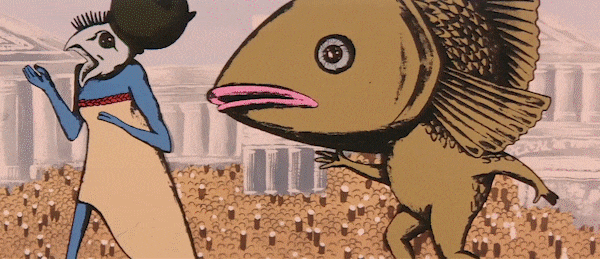
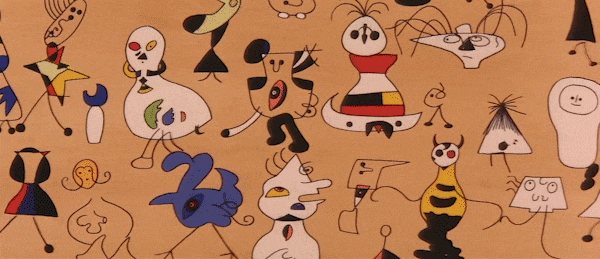
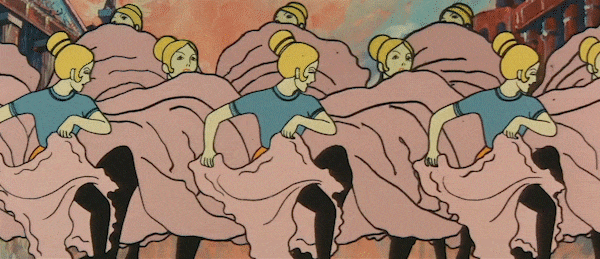
Cleopatra: Queen of Sex . Osamu Tezuka & Eiichi Yamamoto . 1970
1K notes
·
View notes
Text
Belladonna of sadness (1973)
This is the last of Tezuka's animerama trilogy and it was a hard watch. This movie goes over heavy and triggering content so be warned. Jeane is viciously gang r@ped by the Lord of the kingdom and his generals on the day of her wedding. Traumatised and frustrated from what happened, she decides to make a deal with the devil to take revenge on the system.
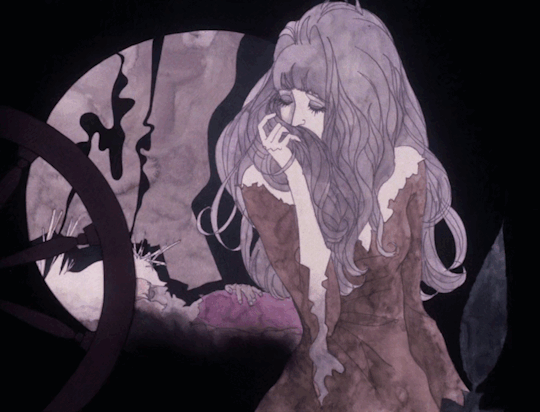
My opinion might be a tad clouded from personal experiences but I got some gripes with the plot. Jeane is only given agency when she gives herself to the devil (who is shaped like a dick btw). So it's like Jeane is strong and defined by her trauma which is a big ol yikes. It feels like the film is trying to arouse the audience at any chance it gets. The nudity, violence and especially the r@pe scenes feel like their designed to be erotic from the way they draw Jeane in these compromising positions. Safe to say that watching this made me uncomfortable. The r@pe scene at the beginning made me disassociate so while my mind's a little fuzzy for that bit it must have been graphic to do that.
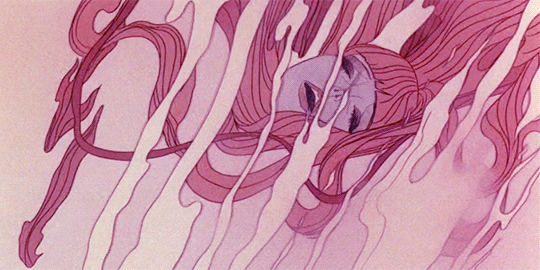
The illustrations are absolutely gorgeous with lovely watercolour art and changes medium every now and then. Animation isn't too common so more often than not the movie uses stills. When it is animated it's smooth and nice to at (out of context at least).
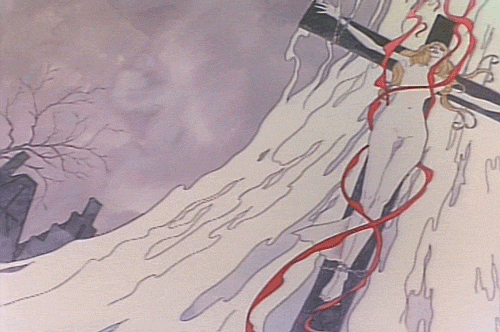
Belladonna of sadness left a bad taste in my mouth, it's such a shame since the art is so beautiful. I think the story could have worked with tweaking but as it is now it isn't something I'd recommend. I'd say to just Google the art and watch some other movie that handles these topics better. Promising young woman is supposed to be good so that might be a good substitute.
The list
#animated movies#animation#every animated movie#animation history#movies#film#old movies#1970s movies#1970s#70s films#70s#1973#japanese animation#anime movie#animerama#anime#osamu tezuka#belladonna of sadness
8 notes
·
View notes
Photo

EIICHI YAMAMOTO /
Sen’ya Ichiya monogatari - Les Mille et Une Nuits (1969)
Film d’animation, 128′ minutes
Les contes des mille et une nuits revisités par Osamu Tezuka, premier segment de la trilogie Animerama emporté par Mushi Production et réalisé par Eiichi Yamamoto.
#les mille et une nuits#Senya Ichiya monogatari#Eiichi Yamamoto#Osamu Tezuka#mushi production#animerama#animation japonaise#animation
26 notes
·
View notes
Link
BELLADONNA OF SADNESS (KANASHIMI NO BELLADONNA) – Animation, 1973, Cinelicious Pics, 89 min., Japan. One of the great lost masterpieces of Japanese animation, never before officially released in the U.S., BELLADONNA OF SADNESS is a mad, swirling, psychedelic light-show of medieval tarot-card imagery with horned demons, haunted forests and La Belle Dame Sans Merci, equal parts J.R.R. Tolkien and gorgeous, explicit Gustav Klimt-influenced eroticism. The last film in the adult-themed Animerama trilogy produced by the godfather of Japanese anime & manga, Osamu Tezuka and directed by his long time collaborator Eiichi Yamamoto (“ASTRO BOY” and “KIMBA THE WHITE LION”), BELLADONNA unfolds as a series of spectacular still watercolor paintings that bleed and twist together. An innocent young woman, Jeanne (voiced by Aiko Nagayama) is violently raped by the local lord on her wedding night. To take revenge, she makes a pact with the Devil himself (voiced by Tatsuya Nakadai, from Akira Kurosawa’s RAN) who appears as an erotic sprite and transforms her into a black-robed vision of madness and desire.
1 note
·
View note
Note
aaah yes, Belladonna of Sadness, the final in the ANIMERAMA trilogy of films! (just watched a hella informative panel about this the other day!)
if any nerds would like to learn more, highly recommend. A deep-dive & history article in 6 parts!
buuuuut if wanna just skip to Belladonna specifically
I remember seeing a post floating around on Tumblr about a 1980s anime movie that had some strong parallels to utena (especially with the rose bride and rose related imagery I think) but now I can't remember the name or find the post. Since you're the resident utena expert I wondered if you have any idea about what movie that could be or if you knew of any other stuff that might have had influence on utena and would be worth checking out. If not no worries and thanks for all the great work you do.
I'm going to guess the movie you're thinking about is Belladonna of Sadness, though that's much older, at 1973. Note: EVEN THE TRAILER HAS EXPLICIT NUDITY AND STYLIZED BUT HONESTLY PRETTY SHOCKING DEPICTIONS OF RAPE.
youtube
I honestly can't recall if anyone in Be-Papas ever brought this movie up specifically, but I cannot stress enough how obviously it is part of the DNA of Revolutionary Girl Utena. This was a film absolutely all of the creative team would likely have seen. Not only is it a major work of animation from the era, it's very much adjacent to the world of 70s ass musical theater abstract rage art that Ikuhara ate up so hard that alumni of it ended up working on Utena. (Seazer doing the duel choruses, there's even a lost musical by Ei Takatori, more on that another day.)
This isn't one of those 'lol check out this shot to shot comparison it's identical' kinds of things. While Ikuhara makes explicit references more often in later work to pop culture of note, Utena's vibe is more about digesting those inspirations, instead of decorating with them. Belladonna of Sadness is a film that feels like Utena content when you watch it. Visually, it's so much its own thing, but the shocking delicacy of Utena's most explicit scenes, the way rape is depicted, those sensibilities definitely have their origin in this film, in part.
It's not an easy watch, definitely look into content warnings for it, but those pass for you, it's probably one of, if not my top, recommendations for what to explore to find Utena's inspirations.
Another film with similarly deeply obvious vibes:
Lost Highway: This David Lynch film came out while Utena was being produced. I saw it before seeing Utena because I was Smashing Pumpkins trash as a teenager and they did a bop for the OST. I can't stress enough how much the Akio Arc is inspired by this film. Don't believe me? Listen to this:
youtube
The work of Shuji Terayama is very obvious as inspiration spiritually for Utena, especially Throw Away Your Books, Rally in the Streets. However, I caution anyone interested in that end of the Utena universe to tread *very* carefully, this content gets honestly fucking horrifying sometimes. Explicit abuse and rape will be depicted in much of this content. Themes Utena shares, but depicts very differently, for a very different audience.
Anyway, hope that helps! Or at least is interesting!
-Vanna
287 notes
·
View notes
Text
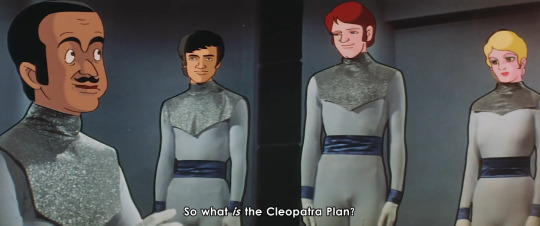
Upon finishing Cleopatra: Queen of Sex, I am left with one simple, rather frustrating question to have at the end of any movie: What was the point?
I can’t help but compare it to Belladonna of Sadness, the film following this one in the Animerama trilogy, and lament Cleopatra’s apparent lack of purpose or narrative vision. Because while Belladonna of Sadness is quite a troubling movie to me personally – I simply cannot call it feminist, and I find it harder and harder to not just admit it is really, very misogynistic despite Eichii Yamamoto’s attempts to grapple with feminist ideas therein – I cannot say it wasn’t trying to impart a meaning, or even that it didn’t succeed in doing so. It was very squarely, definitely, about something. I came away from Belladonna of Sadness shocked, sad, and sympathetic – even if that sympathy was and is still conflicted.
On the other hand, Cleopatra: Queen of Sex left me puzzled and somewhat disgusted, and I don’t even think it was on purpose. And yes, I’m a 28 year-old harpy woman feminist whatever, of course I took umbrage with a 70s cinemax porno anime movie, what did I expect? But that really didn’t even turn out to be my main complaint. In fact, that didn’t even make it into the Top 3 problems I have with this movie, which are as follows:
3. Cleopatra, kind of like Jeanne now that I think about, didn’t actually have much agency and just sort of reacted to the story unfolding around her, despite being the main character. This is exacerbated by having her actions be controlled by another, much more wicked older woman throughout who is doing all of the planning for her.
2. The time-travel framing narrative was completely nonsensical, unnecessary, and went ignored for the vast majority of the movie.
and 1. The ending of the framing time-travel narrative is in complete opposition with the preceding 1 hour and 40 minutes of the story.
Now, I said that the time-travel framing narrative went ignored in the majority of the movie, but that isn’t technically true. If you must know, the time-travellers passively sitting inside of the brains of the ancient people – and a leopard – did contribute One thing to the story throughout: raunchy, absurdist humour. The man inside of Cleopatra’s pet leopard seemingly kept his consciousness somehow, since he was a perverse dunce that facilitated bestiality jokes, just as he did before he got stuck inside the body of an ancient leopard. What a blessing. Thank you Tezuka, for showing me various images of a wacky cartoon leopard trying to have sex with human women.
The other time-travellers ended up in the bodies of humans, a roman slave and a young woman who was a close friend of Cleopatra’s. They, for some unexplained reason, were not consciously controlling the bodies they are inside of, nor were they able to investigate anything despite that being the main conceit of this journey. The roman slave is able to craft explosives and, ridiculously, a handgun, but he has no idea how he knows how to do these things or why he is compelled to. He says vaguely, “someone in my heart is telling me how to do this” and “I made this on impulse, I have no idea how it works”. The young woman does not feel any similar impulse or have access to hidden future knowledge – she may as well have never been possessed at all. Her life goes on exactly as we would assume it would had she not been.
All of the things these three characters do, whether they had been possessed by time-travellers who do nothing anyway or not, could have simply not been done at all and nothing in the story would be very different. History would have played out the same way regardless if the roman slave won his coliseum battle by shooting his opponent with a handgun, and other similar absurdities. Cleopatra steals that handgun afterwards and threatens to kill Calpurnia with it for stealing away Caesar, but Calpurnia convinces her otherwise by showing her that Caesar doesn’t love her, so Cleopatra doesn’t even end up using the gun to change the outcome of history. And need I even explain how whether or not the leopard wants to hump various women doesn’t matter at all, beyond facilitating crude humour, the same way the imagery of a roman slave holding a glock facilitates absurdist humour in this movie?
And it was still not necessary to include them even for the sake of just facilitating humour. There are tons of elements in this movie that are purposely “out of time and place” for the sake of absurdity. All the montages of fine art parodies from around the world, the scene of the various famous statues that have Caesar’s likeness forced onto them after he becomes emperor, Caesar’s assassination playing out like a Japanese stage play. Caesar literally returns to Rome with Cleopatra in a red sports car. This movie never claimed to be aiming for any sort of historical accuracy – we even got a disclaimer about that right off the hop! – we didn’t need any reason for the roman slave to be able to craft a gun, or for the leopard to be horned out of his mind, or the girl to do… nothing…
Functionally the only thing the time-travel framing narrative did was render this movie meaningless in the end. The reason the time-travellers went to the past was to figure out why an alien race on an alien planet called Pasateli, which Earth is trying to conquer, have named their plans for rebellion against Earth “The Cleopatra Plan”. They watch the real Cleopatra’s life unfold in ancient Egypt, and return to the future saying that they now understand what the “The Cleopatra Plan” might be.
The aliens of Pasateli have been sending beautiful women to Earth to seduce the earth men and then, when they are vulnerable, kill them. Upon discovering this, earth launches missiles to Pasateli to destroy it, and the movie ends.
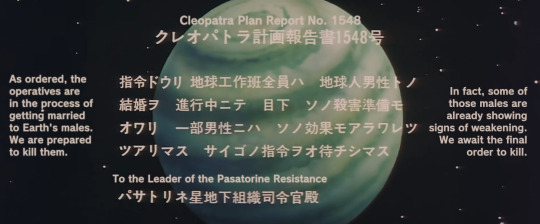
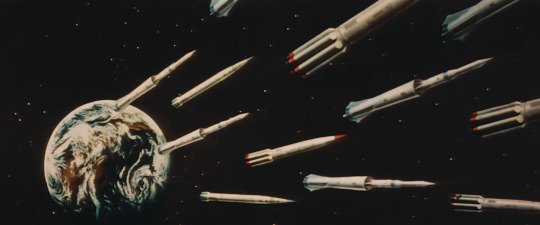
But Cleopatra was not a conniving, wicked woman trying to destroy mankind – this movie does not present her as such. She was being guided and pressured by Apollodoria, and even so, she resisted her demands and fell in love with both of the Roman leaders she had been tasked with assassinating. For an hour and 40 minutes we watch this story about this poor woman who cannot bear to kill the men she loves, not even for her beloved Egypt. Even when Caesar betrays her love, she does not plot revenge or kill him where he lay – she runs away in sorrow. And after Antony dies in his battle against Octavian, helped by Apollodoria’s meddling and poisoning, Cleopatra tries to run away and live in solitude, saying she wants to go back to the way she was before and live a normal life. But Octavian chases her down, helped by the vengeful Apollodoria, and Cleopatra dies when her desperate final attempt to assimilate with the Romans for the sake of survival fails against Octavian, who is immune to her charms because he is gay. (And by the way, in this mess of a story, what is that supposed to mean?)
Similarly, the Egyptians of the movie were clear victims, analogous with the aliens of Pasateli whom Earth was trying to conquer. After Cleopatra committed suicide, faced with being captured and executed by Octavian and having no choice but to do so, the young Egyptian woman one of the time-travellers ended up inside of screamed and cried and begged for the Romans to leave Egypt. That is how the story that takes place in ancient Egypt ends, with an Egyptian woman begging for the conquerors to leave them alone. And then we hard cut to the future and the time-travellers just glibly say, Oh, the Pasateli are trying to destroy us by seducing our men, just like Cleopatra did! Even though in this story, she didn’t.
It is awful. It is insanely misogynistic. It is weirdly conspiratorially racist and brings to mind the bogus “great replacement” theory that neo-nazis insist is definitely real and happening (it isn’t). It makes no sense.

I could try to spin it differently, and try to make a bold claim that this movie is actually about how humans never learn anything from history. How else can you justify none of the time-travellers, particularly the woman who had resided inside of the mourning Egyptian, not pausing and asking: Wait, are we the baddies? Are we the Roman conquerors that drove the titular Cleopatra to desperate measures and an early demise? Are we the villains incapable of witnessing and understanding the violence we are perpetuating even when it is staring us directly in the face?
But that’s a hard sell and one I cannot actually endorse, because this movie did nothing to earn that interpretation beyond have bafflingly bad writing that forces you try to make sense of it. And because there is a comedy scene wherein Egyptian women band together and plot to exhaust the Roman soldiers in Antony’s army with sex prior to his battle with Octavian’s army, ensuring he loses. And it works.
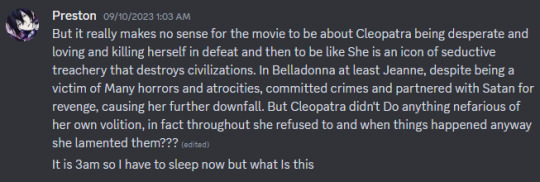
So was this time-travel framing narrative worth witnessing for the sake of laughing at the horrendously rotoscoped anime heads atop live-action actors in a kitschy sci-fi lab? Not in my opinion, no, even though I do love to see animators experiment and I do love feeling like I’m going insane sometimes. And while I can appreciate the artistry of this movie – and there is a lot of it to enjoy! – I have a big problem when a story like this is so contradictory. And no, it being an experimental adult movie from the 70’s doesn’t absolve it of having bad, confusing writing and being dissatisfying.
4/10 for some compelling visuals and a lot of experimental animation that kept things fresh, but it was majorly dragged down by a story that was a little too careless to just be dumb entertainment.
#:Cleopatra#cleopatra 1970#cleopatra: queen of sex#Octavian did slay the entire house down every time he was on screen but alas. He could not save this movie#readmore because I ended up typing 1673 words about this -_-
3 notes
·
View notes
Photo

Greatfully inspired by this Poster of Osamu Tezuka's 1969 adaptation of "One Thousand and One Nights" As far as I love Disney's adaptations of Famous Fairy Tales, much like with my love for Greek Mythology, I enjoy and love people's takes on FairyTales and it's just so interesting to see people having their own takes on an Old Story. Last Night, I have watched the 50s animated adaptation of the Famous Collections of Arabin Stories called "1001 Arabian Nights" with Mr. Magoo and it was pretty swell to say the least. But out of all of the Animated One Thousand and One Nights adaptations that I have seen besides than Disney's take on "Aladdin and the Magic Lamp", I really love Tezuka's version of the Arabin Collection of Stories as a mixture of all Three of these stories (most notably that being Sinbad the Sailor himself). Considering that a lot of Cultural Myth stories (including ones from Greek Mythology) have inspired a lot of Fairy Tales, I figure why not draw a little Fairy Tale/Greek Mythology inspired painting with a little bit of randomness to it Since Poseidon in "Sponge On The Run" is potrayed as Vain and Selfish, he happens to love his own culture since he is canonically an Ancient Greek Deity and considering on how he deeply loves Salacia in my AU, I always imagine some Old Master Romantic paintings with them together. I wanted to make a reference towards one of the most Underrated Adult Anime media ever since while Osamu himself is one of the most popular Japanese Manga Artists, his Animerama Trilogy is Criminally Underrated as Hell and I'm mainly a huge fan of Old School Classic Anime. SpongeBob SquarePants (c) Stephen Hillenburg Poseidon, Salacia, and Arion (c) Greco-Roman Mythology
#spongebob squarepants#the spongebob movie sponge on the run#sponge on the run#Greek Mythology#Roman Mythology#Greco-Roman Mythology#poseidon#Salacia#polacia#arion
5 notes
·
View notes
Text
Introduction to Japanese Anime
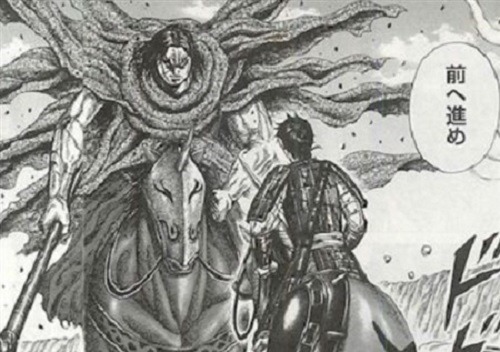
The heritage of anime is notably wide, indeed, and it will consider hundreds of web pages if I will make a chapter about it. I could, but it will acquire a 12 months or a lot more for me to compile it. My key concentrate is not to existing a chronological dissertation of anime heritage in its broadened feeling, considering the fact that it is, as I explained, wide. But it is part of my result in to present to you, the visitors, a simplified presentation of the anime background. So in this post, my lead to is to give a simplified but awakening check out for us Christians about anime and its history. Knowing the historical past, of training course, will not make us ignorant of modern sophistication. Additionally, as Christians, it is significant for us to know or to trace back the roots right before we jump into temptations of any type. To commence with, the word "anime" is mainly dependent on the initial Japanese pronunciation of the American word "animation." It is the model of animation in Japan. The Urban dictionary defines it stereotypically as: the anime type is characters with proportionally huge eyes and hair types and colours that are pretty vibrant and unique. The plots vary from incredibly immature (kiddy things), via teenage level, to experienced (violence, content material, and thick plot). It is also vital to note that American cartoons and Japanese animes are unique. The storyline of an anime is additional advanced when that of a cartoon is more simple. While cartoons are supposed for little ones, anime, on the other hand, is additional meant for the adult viewers. Whilst the creation of anime was generally due to the impact of the Western international locations that started at the start off of twentieth century (when Japanese filmmakers experimented with the animation procedures that were getting explored in the West) it was also encouraged by the manufacturing of manga (comic) that was already existing in Japan even prior to the creation of anime. Around the beginning of the thirteenth century, there were by now images of the afterlife and animals appearing on temple walls in Japan (most of them are equivalent to modern manga). If you beloved this short article and you would like to receive additional information concerning キングダムネタバレ!最終回の予想や物語の結末まとめ kindly visit our own web page.
At the commence of 1600's, pics were being not drawn on temples any lengthier but on wood blocks, recognized as Edo. Subjects in Edo arts were being less religious and have been normally geographically erotic. Noting this, without having a question, it gave me this insight: "The specific shows of manga, that would afterwards influence the industry of anime, ended up by now existent in the thirteenth century. That is hundreds of years just before anime emerged into perspective!" Now it should not be too astonishing, appropriate? There are several mangas (also acknowledged as comics) of these days that are as well vulgar and explicit and if not, there will be at minimum one character in her showy overall look. I'm not stating that all mangas are whole of nudities, if that's what you happen to be wondering by now. But somewhat, this exploitation of eroticism (or at the very least a trace of amorousness) on mangas is not really new. They already existed even before the World War I and II. They, on the other hand, sophisticated into some thing else. Manga, to a good extent, is a component as to how and why anime existed. In truth, most animes and are living steps are diversifications of mangas or comics. Japanese cartoonists currently experimented with various fashion of animation as early as 1914, but the wonderful advancement of anime however started soon soon after the Second Globe War where by Kitayama Seitaro, Oten Shimokawa, and Osamu Tezuka ended up pioneering as then notable Japanese animators. Amid the pioneering animators during that time, it was Osamu Tezuka who attained the most credits and was later identified as "the god of comics." Osamu Tezuka was very best recognised in his do the job "Astro Boy (Tetsuwan Atomu)" the first robotic boy with an atomic coronary heart who had wished to be a actual boy. His functions ended up noteworthy and his design and style of animation contributed a great deal in the production of Japanese anime, these types of as massive and rounded eyes. Tezuka's functions did not only emphasis to entertain youthful viewers but he also conceived and initiated the creation of Animerama. It is a collection of thematically-relevant grownup anime characteristic movies made at his Mushi Production studio from the late 1960's to early 1970's. Animerama is a trilogy consisting of a few films: A Thousand & A person Nights, Cleopatra, and Belladona. The first, A Thousand & One Evenings, was the very first erotic animated film conceived by Osamu Tezuka, the god of comics. Whilst anime built its way, it was only in the 1980's that anime was totally recognized in the mainstream of Japan. Due to the fact then, a lot more and extra genres emerged into remaining. From slice of lifestyle, drama, mechas, tragic, adventure, science fiction, romance, ecchi, shounen-ai, shoujo and a ton much more of genres. Whilst most of the anime reveals shifted from much more superhero-oriented, fantastical plots to fairly more reasonable room operas with ever more sophisticated plots and fuzzier definitions of appropriate and incorrect-in brief, anime in its broadened sense is just complicated. Furthermore, afterwards all through the boomed expertise of Japanese animation, a new medium was then designed for anime: the OVA (Unique Video Animation). These OVAs were being immediate-to-house-video collection or films that catered to a lot smaller audiences. The OVA was also dependable for allowing for the initial total-blown anime pornography. As Japanese animation even more received extra viewers and acceptance during the planet, a subculture in Japan, who afterwards identified as themselves "otaku", began to establish all around animation journals these types of as Animage or later NewType. These publications grew to become known in reply to the too much to handle fandom that produced all-around reveals such as Yamato and Gundam in the late 1970's and early 1980's and during this period the mecha genres had been distinguished. It all begun from historical paintings, wooden block arts, creative depiction of lifestyle, mother nature, and animals as early as the thirteenth century. Until these, nonetheless, evolved into relocating frames when distinct experimentations of mangas and animation were being made in the pre and post-wars era. Even as early as 13th century, mangas on wood blocks, acknowledged as Edo, were previously existent not only for the sake of art but it was there I believe as a medium of entertainment... a kind of art and leisure that would gradually advanced in time. In conclusion, the background of anime was broad in its sense and this write-up has not presented all of it. But the position is, we must know that anime by itself carries a whole lot of genres and motives that can be alarming more than we can imagine.
0 notes
Text
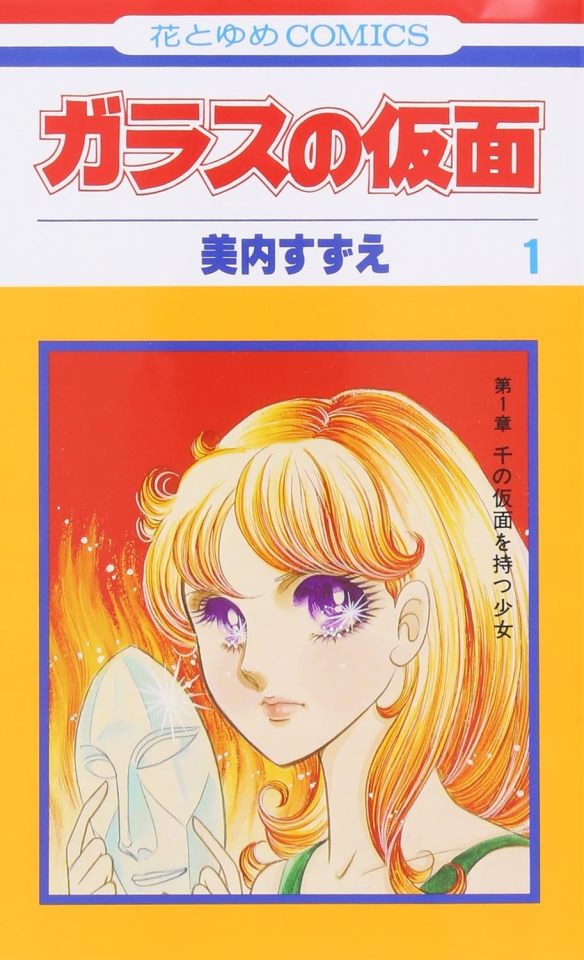
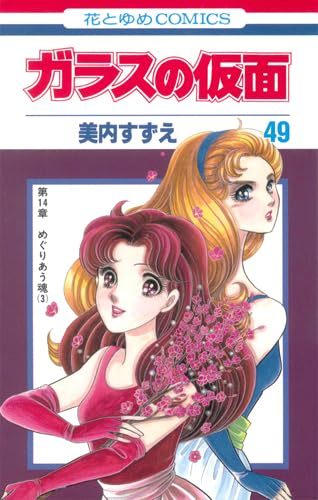
pulling a random paper sleeve from the trash bag they've been sleeping in, my first salvage of the day is... The original 1984, "Glass Mask"/GLASS no Kamen, adapting the classic 1970s manga of the same name, by Suzue Miuchi. (And right behind it two DVDs of the 2005 remake)
The original manga started running in Hakusensha's Hana to Yume/"Flowers & Dreams" shoujo magazine(and later its, now defunct, supplementary magazine, Bessatsu Hana to Yume) in 1976 --The magazine itself started in 1974-- and ran until 2012 (with a little gap between 2006 and 2008) when it was put on its now indefinite hiatus. With over 50million copies sold across 49 volumes, it is one of the best selling shoujo manga of all time. Especially impressive considering Hakesensha is a bit of a runt of the litter in terms of big manga publishers; they're not exactly "small" but they don't stack up anything close to the big hitters like Shueisha, Kodansha, of Shogakukan.

The 1984 anime was by Studio Eiken, whom are kind of all but forgotten these days. They really peaked between the 80s and 90s, but were responsible for a handful of real foundational classics. They did Tetsujin-28 and 8-Man, which were of course the basis for early American anime imports Gigantor --one of the early giant robot series-- and Tobor The 8th Man --which would go on to influence the creation of Robocop, and get a shout out in Big O.(the electric eel episode is an almost shot for shot remake of an 8-Man episode.)
The director of the original TV series was Gizaburo Sugii who is himself a real monolith of the early anime industry. He was an animator on White Snake Legend/Hakuja-den(Panda and the Magic Serpent in English) an early anime film adapting the Chinese Lady Whitesnake myth, often cited as part of what inspired Hayao Miyazaki to become an animator. Gizaburo, like Osamu Tezuka, for whom he worked, was himself inspired by the Japanese theatrical release of Disney's Bambi. He was also an animation director on the original Tetsuwan Atom/The Mighty Atom (aka Astroboy in English). He's been a key figure behind a bunch of classics, often sports series, and in Mushi Production's Animerama film trilogy, as well as a few iterations of Lupin III and Street Fighter, but perhaps his most uniquely enduring work was as the creator behind Night on The Galactic Railroad, adapting the 1934 Kenji Miyazawa novel.
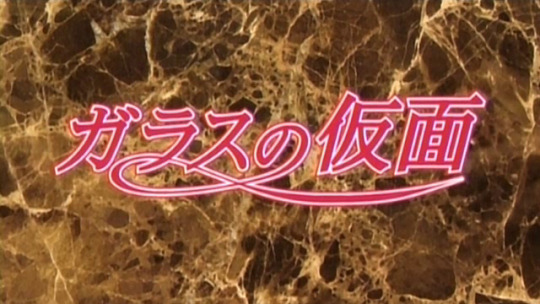
The 2005 series had a different kind of big name behind it: Mamoru Hamatsu. He may not have been a godfather to the art or the industry, but he was no slouch as far as pop culture hits go. He's the director behind the original Dirty Pair and Urusei Yatsura, Yoroiden Samurai Troopers aka Ronin Warriors, all of which had substantial success in English release, and some big but slightly B-list giant robot series like Giant Gorg and King of Braves GAO GAI GAR.
#glass mask#glass no kamen#suzue miuchi#gisaburou sugii#mamoru hamatsu#leop and the great archival update endeavor
3 notes
·
View notes
Photo

“Belladonna” (哀しみのベラドンナ Kanashimi no Beradonna, literally “Belladonna of Sadness”), also known as “The Tragedy of Belladonna”, is a 1973 feature film produced by the Japanese animation studio Mushi Production and distributor Nippon Herald Films. Directed and co-written by Eiichi Yamamoto and inspired by Jules Michelet’s non-fiction book Satanism and Witchcraft, it is the third and final film in the Animerama trilogy and the only one to be neither written nor directed by Osamu Tezuka (he left Mushi Production during the film’s early stages to concentrate on his comics and his conceptual-stage contribution is uncredited). Belladonna is also of a more serious tone than the more comedic first two Animerama films. Its visuals consist mostly of still paintings panned acrossand are strongly influenced by western art, such as Aubrey Beardsley, Gustav Klimt and classic tarot illustrations.
#Belladonna#Kanashimi no Beradonna#Belladonna of Sadness#The Tragedy of Belladonna#anime#film#Japan#Animerama#inspired#book#Jules Michelet#Satanism and Witchcraft#Osamu Tezuka
43 notes
·
View notes
Text
Top Physical Anime Releases of 2016

I wish I could spend this entire month making "Best of the Year" lists for 2016, but unfortunately, it would be disingenuous to do so. Most of the media I consumed this year was either older or just not strong enough for me to promote. However, there is a year-end list that is entirely made up of content not released in 2016 I consumed that I can put out: A List of my "Ten Favorite Anime Home Video Releases". That’s an overly specific title, but pedantry is something that comes with the territory. I am by no means an expert in the field of disk encoding nor would I say I’m well versed in all the goings on with the way anime is distributed, this is just a list containing the anime I was happy to see got a release or a re-release this year with a few honorable mentions. I’m also limiting this list to North American releases, only because I have even less knowledge of other regions' anime markets. Since this post is rather long, I’ve provided a list of the anime I’m going to cover here making it easier for you to search for a particular title.
Table of Contents
Shirobako (Honorable Mention)
Maria the Virgin Witch (Honorable Mention)
Otaku no Video
Belladonna of Sadness
Gundam Thunderbolt
The Girl Who Leapt Through Time
Dai-Guard
The Vision of Escaflowne
Dennou Coil
Only Yesterday
Getter Robo Armageddon
Sword of the Stranger
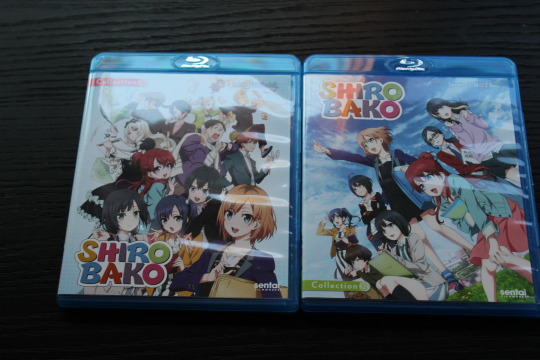
Shirobako: As impressive as this show is I wouldn't call the anemic release it got this year a must buy. A shame as the release and popularity of Shirobako in the West has aided in the significant change happening to the western anime fandom in recent years. The show opened a lot of eyes to the struggles inherent in creating anime, leading to a greater appreciation of the medium as a whole. I've seen it spur on people already present in a community branch out and diversify the type of content and critique that gets produced about the medium. These claims may be a bit unsubstantiated, but I’ve known a lot of people who after watching and enjoying Shirobako got a fire lit under them to really dive in and give back to the community/industry more than they had before. The knowledgeable and passionate members of our community are creating more content than ever that help breaks down the barriers between consumers and creators that appeared to exist for decades. Slowly we’re coming together to support these fans turned scholars and the medium of anime more and I can’t wait to see what 2017 brings to the table in this way. Unfortunately, as I mentioned earlier, my hyperbolic statements about Shriobako and what it may or may not have done for this community aren't reflected in this two-part Sentai Filmworks release (nor could they ever realistically be). With the show available to stream currently on Crunchyroll as well as Sentai’s oft-forgotten The Anime Network and its license nowhere near close to expiring this is a show you don’t need to run out and buy immediately. Frankly, if you’re still fanatical about the show you probably bought a bunch of character goods or the second pressing of the Japanese Blu-rays. I bought this domestic release an impulse buy because Amazon has decent pre-order discount and I had the leftovers of a birthday gift card. For everyone else who wants to buy I suggest you wait until Sentai inevitably releases a complete series set.

Maria the Virgin Witch: Another impulse buy, this the result of a Rightstuf.com holiday sale daily deal, but one I’m less regretful supporting early. What pushed me over the edge to buy it is because I am almost certain this gem of the Winter 2015 season will continue to be overlooked. It may be in part due to its title or the fact that a lot of anime fans tend to check out during the winter season. Either way, this show about a witch in an alternate history version of a European conflict is far more engaging and endearing than the one that aired in 2016 (though those are the only similarities between Maria and Izetta I swear). I want to talk about this show for the blog this year, so I don’t want to spoil too much. I will say that you can currently stream it through Funimation or Hulu and with Funimation’s partnership with Crunchyroll I’m sure it will enter their catalog as well next year (which would be a good time to release whatever I’ve written about it). Until then this show is destined to reach Funimation’s S.A.V.E. line in the coming years as a lot of good shows, unfortunately, do in this era of overwhelmingly huge anime seasons.

Otaku no Video: Probably the most impressive complete package I bought this year, Animeigo’s remaster of this classic OVA/Live-Action documentary by studio Gainax is pure shelf candy. I had slept on their remastering of Bubblegum Crisis, but I was enthusiastic in backing their second Kickstarter to give this essential commentary on fan culture the high-definition treatment it deserved. This limited edition comes in a solid chipboard box and includes an 180+ artbook on top of the additional audio commentaries, liner notes and three language tracks provided in the standard Blu-ray release. Though OVA itself looks better than it ever has the documentary, being not shot on 35mm film, looks decidedly more dated but less compressed than it did on the older DVD release. Robert Woodhead and everyone involved deserve high praise for the package they put together, and I would suggest any anime collector to grab the standard Blu-ray copy if they are the least bit interested. While I came from the generation of anime fans that grew after this project, I still find the topics it brings up relevant to fan culture today. There are numerous anime now that star “Otaku” now but the reasoning for almost all of those shows to do so is purely self-referential. The main character/characters are “Otaku” because the writer is one, and it gives them carte blanche to so how genre savvy they are to their majority otaku audience. Very few of these shows tackle the issues brought up about fan culture, and instead the "Otaku" character archetype has become so emblematic that it’s almost become a necessary cliche for a lot of writers to fall back on. So when I see shows that set out to address fan culture it makes me elated to watch. Shows like Genshiken, Welcome to the N.H.K. Comic Party and even Lucky Star to an extent come from a more genuine place. Whether this place is a more critical or celebratory doesn’t matter to me as it does to a lot of other fans and Otaku no Video clear cut between the fun-loving OVA and the far more sobering documentary may turn off some viewers. Sure both halves aren’t as seamlessly melded together as in later series but they are two halves of an essential whole, and I urge you to watch both if you haven't to gain the full experience.
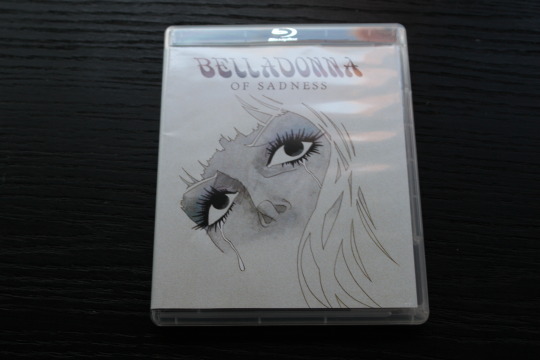
Belladonna of Sadness: I adore this film and relish in its beautiful restoration, but I’m at a loss for words with how to sell it to those not already in the know. Conceptually Belladonna of Sadness your straightforward rape revenge story but its presentation is anything but, not only in the realm of anime but animation as a whole. Belladonna is the final of the three Animerama films made by Osamu Tezuka’s Mushi Productions, a project that aimed to create more adult-oriented animation. It’s by far the shortest of the three films and, from what I believe is due in part to Tezuka’s lack of involvement, by far the most serious. Still, it shares the trilogy's real sense of wanting to experiment with animation on top of showcasing more mature storylines. Belladonna tale is shown through ornate watercolor stills, their elegance worthy of presenting in any art gallery. Despite showcasing limited animation for an animated feature the use of these still images through cinematography manages to make its tale no less poignant. However, in movement Belladonna is a surreal journey unlike anything on celluloid. The closest comparison I have are some of the films of Ralph Bakshi but even the most psychedelic of his sequences appear far more grounded than Belladonna’s phallic parade. The use of color and sound in these moments would be electrifying by themselves, but given the stationary nature of the film these energetic and unearthly sequences stand out even more. Despite all my praise, I understand that not everyone is as willing as I am to watch a 1970s, experimental, anime rape-revenge flick that is made up of mostly watercolor paintings let alone run out to purchase it. Luckily Amazon has it for streaming for Prime members so if you’d like to try it before adding it to your collection or just want to watch something daringly different be my guest.

Gundam Thunderbolt: In a year where Nozomi was putting out a Gundam release every month, fans of the long time mecha franchise, such as myself, were downright spoiled for choice when it came to collecting the series on home video. If I was a more die-hard fan I could have made a list consisting of almost nothing but Gundam titles, but I decided to have one release represent the franchise this year. I could have chosen traditional favorites such as Zeta Gundam, 0080 War in the Pocket or Char’s Counterattack. The oft-maligned ZZ Gundam or underrated series like Victory Gundam and After War Gundam X, surprising newcomers in Gundam Build Fighters and Gundam Build Fighters Try are also appealing buys. The glorious trainwreck known as Reconguista in G was at points calling my name to defend it here and if I really wanted to send I could have even chosen the excellent adaptation of Gundam: The Origin which came in some lavishly designed art boxes. However, if I had purchased all of these this year, even taking advantage of every sale and discount possible, I’d have been downright broke. Besides, I have a much better candidate. Gundam Thunderbolt December Sky, the compilation of the previously released four episodes, is probably the biggest piece of fanservice anime I’ve seen so far this decade. From the action choreography to the mechanical design and fluid animation all nestled in a dour military plot where neither side is the clearly in the right: This is the stuff of Gundam fans' dreams. Thunderbolt demands to be viewed in the highest definition possible, its excellent jazz soundtrack and overall sound design pleading for an appropriate surround system and this minimalistic Blu-ray release doesn't disappoint on that front. Where it does, however, is in the included dub. A dub little to most Gundam fans, especially those willing to import a Blu-ray movie, but after coming off one of the best dubs this decade, Gundam Unicorn, this is a real letdown. I’m sure this will still go over well when this eventually airs on Toonami, but I think this could have been casted a lot better. As of this writing, Gundam Thunderbolt isn’t legally streaming anymore, but hopefully when the planned second season comes out, the original will be made available either through streaming or a domestically released Blu-ray. It may be too much to ask most people to shell out for, but this right here is one of the best looking series this decade. Truly a high point for anime and animation in general. Plus one of the leaflets included in this box announces the Japanese release date for the Mobile Fighter G Gundam Blu-rays, which means they can’t be too far out from releasing domestically. I can’t wait to experience that beautifully godawful dub again, this time in high definition.
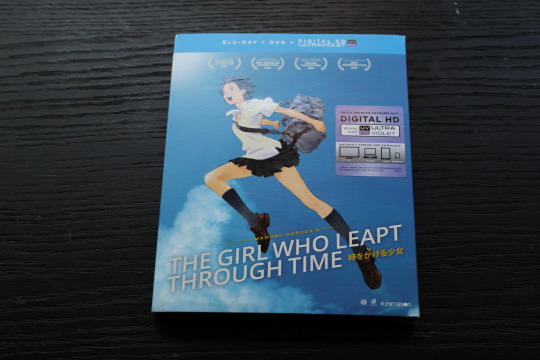
The Girl Who Leapt Through Time: Shinkai’s first non-franchise film initially came to the West with far less fanfare as his name carries now. Sure there were fans of Digimon Adventure: Our War Game! And One Piece Film 6: Baron Omatsuri and the Secret Island but the cultural cache behind the director's name hadn’t exploded yet. The Girl Who Leapt Through Time changed that and probably lead to Funimation’s decision to pick up the rights and heavily market his next film Summer Wars, a film which increased his level of notoriety to the point where people began calling him “The Next Miyazaki”. While still beloved post Summer Wars, The Girl Who Leapt Through Time had the unfortunate distinction of being one of the last anime Bandai Visual had licensed before they closed up shop. The film’s popularity combined with the small print run the Blu-ray received lead to massive price gouging on the secondhand market even for the more readily available DVD copy. Having already acquired the rights to Summer Wars, Wolf Children, and the then upcoming The Boy and the Beast it seemed clear to everyone that a Funimation relicense of this film wasn’t far off. In the meantime, many in the collecting community decided to purchase the frankly stunning South Korean Blu-ray set, though others including myself waited for a far cheaper domestic copy. I bought the standard release although Funimation released a limited edition version as well that I hear doesn't compare favorably when up against the previously mentioned South Korean release. Either way, this major film from a now well-established director has finally been made available again so it can reach the wider audience he has now. Funimation’s release comes with a number of extras on the disks the most valuable being the two interviews with Hosoda. The Girl Who Leapt Through Time might not be in my upper echelon of anime films, but it’s certainly one I enjoy on occasion, even with my general lack of interest in time travel and I'm glad to have it back in my collection in an affordable higher fidelity.

Dai-Guard: In this modern era of anime where new giant robot shows, outside Gundam, are infrequent it sure was kind of Discotek Media to redistribute this forgotten title in the genre. Imagine if events similar to those in Neon Genesis Evangelion occurred except that N.E.R.V. was not a ludicrously well-funded organization and instead had a budget similar to many of our real-life underfunded government organizations. Yes, the angel-like, amorphous threat known as the Heterodyne have returned after humanity's destructive confrontation with them twelves years prior but the only weapon capable of defeating them, the robot Dai-Guard, has seen better days. Now used as a mascot for the military Dai-Guard is barely able to make it through a battle without falling apart. This somewhat more comedic take on alien lifeforms set to destroy earth is one of the many things that set Dai-Guard apart from the many anime the share its premise. Unlike a lot of those anime, however, Dai-Guard is piloted by three people and their conflicting personalities and interpersonal stories, along with those of the rest of the 21st Century Defense Security Corporation add a lot of the flavor and weight to the series. The ensemble cast is what makes Dai-Guard more than your average giant robot show and anyone who's been a fan of office comedies, both in and outside anime, in the past decade will find a lot to enjoy here. Dai-Guard itself, while not the most memorable robot in anime history, is well designed and its signature weapons lead to some very well done fights. This show's more light-hearted tone acts as a nice reprieve in between watching more heady programming, for example, I decided to give this show a rewatch after watching Casshern Sins, and it worked wonderfully as a palate cleanser. As always Discotek does an excellent job maintaining the quality of the original release as well as shipping it in solid packaging. The original dub from the ADV release is here and is on par with what they usually produced back in those days. Overall Dai-Guard isn’t the flashiest show, but much like its titular robot it manages to hold itself together to deliver a satisfying punch to fans of a currently underserved genre.

The Vision of Escaflowne: There was and still is a lot of drama in the anime collectors community surrounding the re-release of this well-loved anime from Sunrise. Funimation’s successful Kickstarter to redub the series was already showing warning signs before funding ended and their handling of the aftermath left a lot of people with a bad taste in their mouths. Needless to say, I doubt they’ll consider using crowdfunding again. I was unable to back the project and therefore I wasn’t privy to a lot of the discussion that took place about it. From what I managed to glean, unfortunately, it looks like an actual resolution hasn’t been met which is a shame that will continue cloud this release. Escaflowne was a huge deal in the western anime fandom upon its initial release and while it’s time in the limelight isn’t as constant as its contemporary Cowboy Bebop it is by no means a show that has aged poorly. Sunrise did an excellent job remastering this title in the Japanese release a few years ago, and the show has never looked better. I’m a bit biased toward the style of the show, being a huge fan of Nobuteru Yuki’s character designs since Chrono Cross, and when you add giant robots into the mix, you have a show that hits me right in the sweet spot. Top it all off with one of Yoko Kanno’s most celebrated scores, and you have a series poised to remain a staple in the western anime fandom for decades to come. As far as the new dub is concerned, it is certainly more up to the standards of new anime dubbing than the original, included with Bandai’s release. I never had a fondness for the original, so I can’t say I miss it. Nevertheless, I’ll still be sticking to the original Japanese for this show, unlike so many other Sunrise shows from this period. If this new dub is capable of bringing in more modern fans to enjoy this classic, then I am all for it supplanting the old one. I’m a bit disheartened that due to the new dub Funimation decided to split the series initially like they do with a lot of their newer acquisitions of similar length. They could have charged the combined price and kept everything in one box, but I guess that’ll happen when this show gets reprinted for their Anime Classics line. In the end, I’m for more people viewing this stunning show however possible either through purchasing these physical sets or streaming through Funimation and hopefully Crunchyroll sometime this year. Despite all of the mishegas, I’m glad to add this series again to my collection. However, I decided not to purchase Escaflowne: The Movie. The movie itself is an odd duck, being a pseudo-compilation movie that also alters many characters and events not just for the sake of time. I tend to find a lot of these movies rather substandard, the exception being The Adolescence of Utena which I have grown to enjoy over time and will be pleased to repurchase along with the rest of the series on Blu-ray in 2017. As for Escaflowne: The Movie I may pick it up for the sake of completion but only further down the road when it’s discounted.
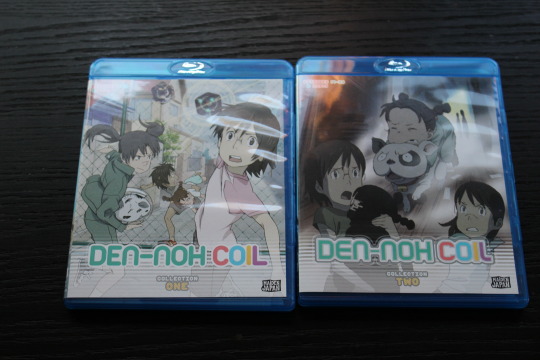
Den-Noh Coil: 2016 was going to be the year that I began importing a lot of anime as domestic licensers were either slow or unable to distribute the shows I wanted. Many these series were made available by Australian publisher Siren Visual, whom I’ve purchased from before to get my copy of Welcome to Irabu’s Office. Luckily Sentai Filmworks stepped in to begin distributing a handful of Siren's catalog in Region A including this one (now if only they or anyone would license Monster or Kaiba). Den-Noh Coil had been a show that struck a chord with me when I found it online in 2008 and was one of the big things I shared with my college anime club when I was asked to run nights. I held out hope that the show would officially available in English, but that wish and the little fanfare the show received subsided as the years continued. It’s a shame the series and its talented creator Mitsuo Iso haven’t become household names, and I’m hoping this late release can help restart the conversation about both. What surprised me most about this release from Sentai Filmwork’s Maiden Japan imprint is that they decided to dub it, and I honestly think it isn’t half bad. I rewatched the first handful of episodes dubbed and while North America’s limited anime VA talent limits it (as it does almost every modern dub) I’d hazard to say it tops Maria the Virgin Witch’s for my personal choice for best dub of the year. Unlike Maria’s I find the dubbing of this show far more important as I genuinely think this is a good show for younger children. The kids in this show look and act like kids and while it gets a bit dark in places there is nothing here that I think would frighten kids more than the cavalcade of horrors I saw growing up watching Don Bluth movies. I also see this show as a good candidate to ease your older friends and family into anime as there isn’t anything here I’d consider objectionable or embarrassing. Besides, a lot of the concepts in this show are moving far closer to the realm of possibility than they were a decade ago. Wearable computers, virtual reality and the omnipresence of technology and how it meshes with where we live are far more relevant topics than they ever were in 2007 due to how tangible all these ideas are to us now especially with kids who grew up only knowing smartphones and tablets. I’m glad I got to revisit this show recently, and I’m hoping more people do in the coming years so I can talk about it with someone. It’s only available to stream through The Anime Network for now but hopefully, some other site (Crunchyroll) will be able acquire it as well.
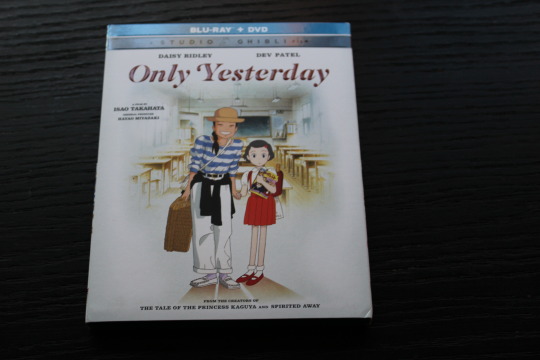
Only Yesterday: It makes sense that this would be the last of the major Studio Ghibli films to see release in North America. A movie about the growing ennui of a late 20-something business woman isn’t something you can easily sell to kids, especially when there isn’t a randomly inserted fantasy sequence such as with the similarly tonal Whisper of the Heart. Still, as I hasten to reach the age of our protagonist Taeko Okajima I’ve only found this film more relatable and it has managed to climb the ranks of my personal “Ghibli Hierarchy”. There was a lot of buzz around this Disney dub starring The Force Awakens' lead Daisy Ridley, but I can’t say I’ve listened to this one yet. I can assure you that the mixed reactions I've heard and read from a lot of people haven't affected my decision to do so. My reasoning for not listening to it is rather simple: I don't want to watch a film grounded in 1980s Japan with English voices. The dub is there for those who want it, and if it manages to get more people to see this movie, then it was worth making. Only Yesterday is a fantastic film worthy of placement in your collection alone, but the over 40-minute making-of documentary included in its extra features make it a must buy for anyone interested in animation production or Studio Ghibli. Not only does this cover a lot of the movie's unique production aspects of the film but the culture of Studio Ghibli at the turn of the decade. Being filmed around Only Yesterday’s 1991 release this is relatively early in the studio’s life, so it’s an excellent snapshot of this period. Being one of Takahata's films we see a great deal of him and his worth ethic both in animation directing and with running the studio, something we, unfortunately, don’t get a lot of due to the cult of personality surrounding Hayao Miyazaki. Of course, Miyazaki is prominently featured here, as well, and this being the early 90s he’s relatively less cynical. Being able to own this documentary that I’ve watched for a number of years is great, and I’m thankful the folks at Disney went out of their way to acquire it again for this release. It's a sizable contribution that makes an already great package truly stellar.
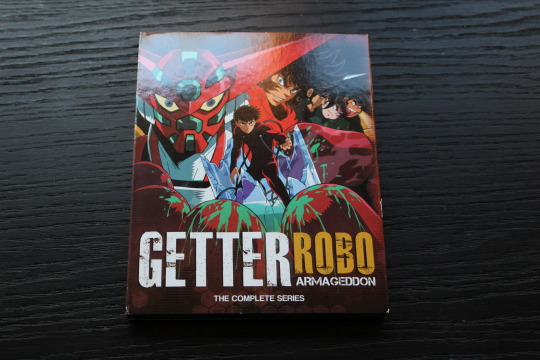
Getter Robo: Armageddon: I tend to have horrible luck when it comes to purchasing old media. Most times I buy something that’s long out of print it gets announced for a re-release within the next few weeks. Getter Robo: Armageddon would surely have been another one of those cases had I not checked Facebook to see Discotek Media’s announcement. I used to show this one as well in my college anime club, and a lot of the folks who were Gurren Lagann fans ate it up. For months I had been waiting for this action-packed OVA to be released in high definition, getting jealous of those who attended summer cons grabbing and early print copies. This gritty, high-octane giant robot show is an enjoyable romp from beginning to end. The remaster not only makes the colors pop, but the improved sound makes all the action scenes for me, that and most of the episodes starting with the second opening HEATS doesn’t hurt either. This entire series scratches that itch for hot-blooded fun and looks marvelous doing it. I’m always happy to support a company like Discotek because time and again they release quality products and Getter Robo: Armageddon is no exception. After the anime crash in the late 2000s, I thought a company like Discotek that only licensed older anime would be a flash in the pan. With every box set and movie, I buy from them I'm reminded how wrong I was in my assumption. Their 2017 lineup is already looking stellar and the fact they announce new licenses almost every other month shows how strong they’ve become.

Sword of the Stranger: You might wonder why I’ve taken a photo of the older Bandai release instead of Funimation’s recent reprinting. This is because despite the Funimation release getting a dub I didn’t feel the need to rebuy something I already owned on Blu-Ray. I’ve heard the dub is fair and the extra features are nice, but neither are spectacular enough for me to double dip so early. Nevertheless, I wanted to bring attention to this great action film’s re-release and if you read until this point in the post you know I’ve already spent my fair share on anime this year so cut me some slack. Sword of the Stranger one of the first names brought up when anime fans want to showcase a great action scene. The choreography the folks at Studio Bones nailed down here is outstanding and worthy of any action showcase. Fans of Fullmetal Alchemist: Brotherhood should be elated in finally getting access to this movie again as that series owes a lot to the style of action created for this film. Not only that but the film as a whole is a solid feature: a simple samurai story told well. There isn’t anything revolutionary going on here plotwise, and the characters are familiar archetypes though not to a fault. It isn’t trying to deconstruct its themes and characters for critique. Rather it comes off as a slick action movie that effortless falls into the greater chanbara canon. I appreciate this film's simplistic approach. It makes for easy sharing with friends and family who don’t usually watch a lot of anime. Sometimes all I want is a good self-contained action movie and Sword of the Stranger delivers and then some even a decade later. My only reservation about picking this one up now is that somehow Funimation failed to include subtitles for the Chinese dialogue, something included in the Bandai release I own. I'm hoping that with the release being so recent and the mistake pointed out that it will be fixed in newer pressings and that those who picked it up early can get exchanges. Maybe 2017 will be the year Funimation also revamps its attitude toward quality assurance? Here's hoping because I'd hate for a great film like this to be dragged down by an easily fixed mistake.
By now I’ve written more than enough about the anime on home video (re)published in 2016. Not only that but some well-beloved classic titles have already been announced for release (again) next year. Featuring plenty of Gundam, Revolutionary Girl Utena Blu-Rays, Urusei Yatsura: Beautiful Dreamer, Captain Harlock: Arcadia of my Youth and if we're lucky more popular Sunrise shows. 2017 looks to be an even better year for those of us who relish in collecting disks and I'll be there, my bank account willing, ready to enjoy it.
See you next week.
#the vision of escaflowne#only yesterday#gundam thunderbolt#the girl who leapt through time#shirobako#maria the virgin witch#den-noh coil#sword of the stranger#da-guard#gundam#getter robo armageddon#getter robo#belladonna of sadness#otaku no video#anime
4 notes
·
View notes
Text
The Witch Within
Whether they stick the landing or not is debatable, but after viewing Belladonna most would agree the tale of Jeanne carries a feminist message. Her hardships and desires are to be synonymous with those of all women. This is most clearly illustrated near the end of the film, when all of the women in the village suddenly bear a striking resemblance to Jeanne after viewing her tied to the stake. The matter of sexual assault and male entitlement in a male-dominated society is as much of a red-hot topic today as it was in the ‘70′s, when Japanese women marched in the streets of Tokyo under the banner of a women’s liberation movement.
One can ask themselves to what end this was intended by Eiichi Yamamoto and Mushi Production. Belladonna of Sadness was the third and final x-rated film released in the studio’s Animerama trilogy in an effort to attract an adult audience. Was this work really were meant to provoke thought and discussion ? Or was this nothing more than another animated bid from a failing studio at competing with the sexploitation genre and pink films of the era ?
That seems hard to believe given the biting edge to Jeanne’s initial sexual experience. To this day the scene is uncomfortable to watch, with visual symbolism that cuts deep and shows no age. After this first occurrence, the nudity and sexual imagery turn playful and become tonally different. The difference here being that now Jeanne has taken the reigns - and in her newfound freedom sex has changed too. Only now that she herself has sexually awakened does the erotic side of the visuals gain the overhand over the traumatic.

When looking at La Sorcière by French author Jules Michelet (the book which served as the main source of inspiration for the events in the film) women’s right pop up yet again. In it, Michelet takes a somewhat proto-feminist stance by sympathising with a female perspective as he recounts the rebellious nature of witches and witchcraft during the Middle Ages. In his words, witches become tragic and rebellious figures who went against religious authority and the established order of the feudal system. By owning their sexuality they opposed the powerful. This idea of a (female) individual disrupting the status quo is easily translated to the story of Jeanne.
From Circe to Morgan Le Fay, the idea of witchcraft as symbolism for female empowerment is nothing new and Belladonna makes full use of this trope (for more on this I highly suggest giving this article a read).
Ultimately, the story is one of desperation. In order to fight against the injustice done to her this woman must sell her soul to the devil, essentially trading one abuser for another. As the cycle continues until it can escalate no further it becomes clear that Jeanne is no feminist ideal. No true equality is achieved here. Her tale is but a cautionary one, proclaiming the need for female empowerment.
sources
https://www.nytimes.com/2016/05/06/movies/belladonna-of-sadness-review-japanese-animation.html
https://search-proquest-com.kuleuven.ezproxy.kuleuven.be/docview/1718193763?rfr_id=info%3Axri%2Fsid%3Aprimo
https://film.avclub.com/the-animated-psychosexual-freak-out-belladonna-of-sadne-1798187658
https://www.rogerebert.com/reviews/belladonna-of-sadness-2016
.
0 notes